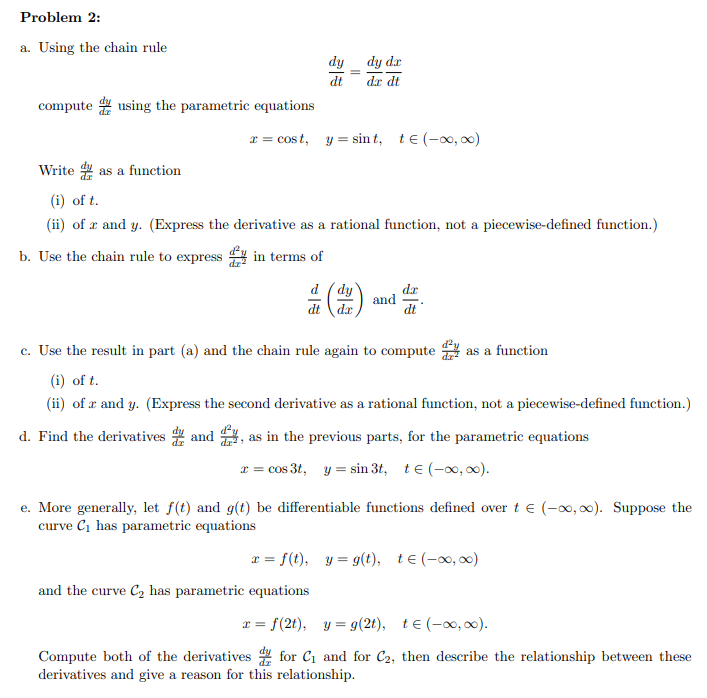compute using the parametric equations I= cost, y = sin t, te (-x, 0) Write as a function (i) of t. (ii) of r and y. (Express the derivative as a rational function, not a piecewise-defined function.)
compute using the parametric equations I= cost, y = sin t, te (-x, 0) Write as a function (i) of t. (ii) of r and y. (Express the derivative as a rational function, not a piecewise-defined function.)
Calculus: Early Transcendentals
8th Edition
ISBN:9781285741550
Author:James Stewart
Publisher:James Stewart
Chapter1: Functions And Models
Section: Chapter Questions
Problem 1RCC: (a) What is a function? What are its domain and range? (b) What is the graph of a function? (c) How...
Related questions
Question

Transcribed Image Text:Problem 2:
a. Using the chain rule
dy
dy dr
dr dt
dt
compute 4 using the parametric equations
x = cost, y = sin t, te (-0, 00)
Write
as a function
(i) of t.
(ii) of æ and y. (Express the derivative as a rational function, not a piecewise-defined function.)
b. Use the chain rule to express in terms of
d (dy
dt dr
dr
and
dt
c. Use the result in part (a) and the chain rule again to compute 4 as a function
(i) of t.
(ii) of r and y. (Express the second derivative as a rational function, not a piecewise-defined function.)
d. Find the derivatives and 4, as in the previous parts, for the parametric equations
x = cos 3t, y = sin 3t, te (-0, 0).
e. More generally, let f(t) and g(t) be differentiable functions defined over t € (-0, 0). Suppose the
curve C1 has parametric equations
r = f(t), y = 9(t), te(-∞,00)
and the curve C, has parametric equations
x = f(2t), y = g(2t), te (-0, a0).
Compute both of the derivatives 4 for C1 and for C2, then describe the relationship between these
derivatives and give a reason for this relationship.
Expert Solution
This question has been solved!
Explore an expertly crafted, step-by-step solution for a thorough understanding of key concepts.
Step by step
Solved in 2 steps with 1 images

Recommended textbooks for you

Calculus: Early Transcendentals
Calculus
ISBN:
9781285741550
Author:
James Stewart
Publisher:
Cengage Learning

Thomas' Calculus (14th Edition)
Calculus
ISBN:
9780134438986
Author:
Joel R. Hass, Christopher E. Heil, Maurice D. Weir
Publisher:
PEARSON

Calculus: Early Transcendentals (3rd Edition)
Calculus
ISBN:
9780134763644
Author:
William L. Briggs, Lyle Cochran, Bernard Gillett, Eric Schulz
Publisher:
PEARSON

Calculus: Early Transcendentals
Calculus
ISBN:
9781285741550
Author:
James Stewart
Publisher:
Cengage Learning

Thomas' Calculus (14th Edition)
Calculus
ISBN:
9780134438986
Author:
Joel R. Hass, Christopher E. Heil, Maurice D. Weir
Publisher:
PEARSON

Calculus: Early Transcendentals (3rd Edition)
Calculus
ISBN:
9780134763644
Author:
William L. Briggs, Lyle Cochran, Bernard Gillett, Eric Schulz
Publisher:
PEARSON

Calculus: Early Transcendentals
Calculus
ISBN:
9781319050740
Author:
Jon Rogawski, Colin Adams, Robert Franzosa
Publisher:
W. H. Freeman


Calculus: Early Transcendental Functions
Calculus
ISBN:
9781337552516
Author:
Ron Larson, Bruce H. Edwards
Publisher:
Cengage Learning